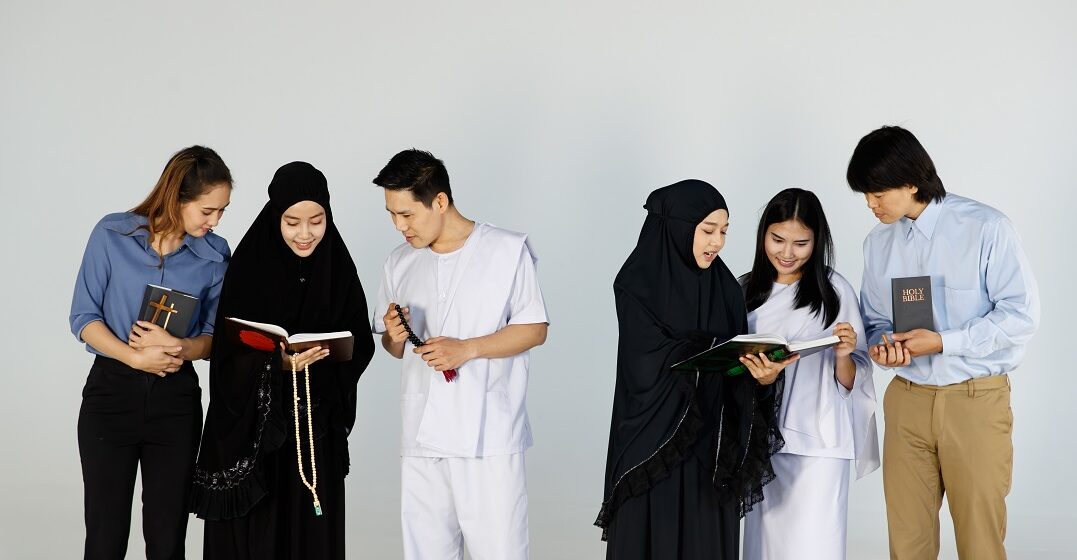Updated on October 29, 2024

All you need to know about religion in France

Let’s start with a word of warning. In France, religion is often considered a bit of a taboo subject. Like politics, it tends to arouse passionate responses and fierce debates. Indeed, the whole of French history is filled with religious tumult, with Christianity (and, more specifically the Catholic Church) playing a major role in transforming politics and society.
France is a predominantly Christian nation, with Catholicism as its historical bedrock. Approximately 51% of the population identifies as Christian, with the vast majority being Catholic. However, France’s religious landscape is diverse, encompassing Islam, Judaism, Buddhism, Hinduism, and other faiths. Despite its Christian heritage, the country has seen a decline in religious practice, making it increasingly secular.
But the France of today is not the France of yesterday. Modern France is home to a much more diverse religious landscape — though sometimes old Republican principles clash with this new reality. With this background in mind, let’s review a few facts about French religion that you should know before wading into this very French conversation.



Christianity has played a major role in influencing the history of religion in France.. An old saying even refers to France as la fille aînée de l’Église (the eldest daughter of the Church). So intense was the Catholic Church’s impact on French culture and heritage that, to this day, several French public bank holidays evince a religious origin. Of course, the same can be said for many of the country’s finest monuments and works of art.
In the second century AD, Christianity spread throughout France. But it was really the rise of the Franks that strengthened its position and power. In the fifth century AD, this originally pagan tribe invaded the country, eventually giving France its name and adopting the Christian religion as their own. Around 498 or 499, Clovis was baptized in the cathedral of the city of Reims and began a long tradition in which the French monarchy legitimized its power through Christianity. Following Clovis’s example, most French coronations took place in the cathedral of Reims, where the new kings received the holy anointing oil.
At the time of the Reformation in the 16th century, many French regions took up the Protestant faith. This was particularly the case in the southwest and in the east. Aside from sporadic tensions, people generally tolerated the new religion. King Henry IV’s actions were exemplary of his times: Protestant at heart, he was forced to convert to Catholicism and be baptized in 1593 in order to access the throne the following year. A few years later, in 1598, he issued the Edict of Nantes, which guaranteed freedom of religion and conscience to les Huguenots (French Protestants). About a century later, in 1685, Louis XIV revoked the edict, which paved the way for persecution and the mass emigration of Protestants from France.
The French Revolution from 1789 to 1799 triggered a shift. It was now the Catholic Church’s turn to be persecuted, with many churches and works of art destroyed. While Christianity regained its place as the country’s primary religion in the 19th century, the new government set some boundaries. La république française disassociated itself from religion and eventually, in 1905, the government finally signed a law to separate church and state.
It should come as no surprise that Christianity, and more particularly Catholicism, remains the dominant religion in France. Around two-thirds of French people identify as Christian, with about 83% of that number identifying as Roman Catholic and 14% identifying as Protestant. However, a large portion of the French population is not actively religious, with church attendance in France ranking among the lowest in the world.
In comparison with Christianity, all the other religions in France are effectively minorities. Islam represents the second-largest faith; with around 8% of its population identifying as Muslim, France has one of the biggest Muslim communities in all of Europe. This is in no small part due to the large number of people of North African origin in France, many of whom migrated to the Hexagone in the 1950s and 1960s following the decolonization of Morocco, Algeria and Tunisia.
The Jewish community represents an even smaller portion of the French religious map. However, it still ranks among the largest Jewish populations in Europe. From the infamous Dreyfus affair to the events of World War II, it also has faced many struggles.
It’s also worth noting that a quarter of the population isn’t affiliated with any religion.
Though the Christian religion has played a major role in French history and culture, its realm of influence has been greatly restricted since the French Revolution of 1789 and the ideas of the siècle des Lumières (Age of Enlightenment). The idea of laïcité (secularism) is one of the cornerstones on which the French Republic is built. The opening paragraph of the French Constitution from 1958 sets the tone:
“La France est une République indivisible, laïque, démocratique et sociale” (“France shall be an indivisible, secular, democratic and social Republic”).
However, it’s important to define the idea behind laïcité and the French adjective laïque, especially since their common translations to the English words “secularism” and “secular” are not exact. La laïcité refers to the complete separation of church and state that was voted in 1905. In fact, it means that no religious body has any saying or influence in public affairs, and vice versa.. This is why, for instance, French weddings must take place at the town hall to be legally recognized by the state.
One of the main intentions of the law from 1905 was to limit the influence of the Catholic Church in education, at a time when many French schools were Catholic. To this day, state schools tend to consider religious topics taboo. Also, it’s forbidden for a state school to have any religious denomination or religious education within its curriculum. Only the religious aspects of French history, art and culture can — and, indeed, must — be taught in school.
In that same tradition, a ban from 2004 prevents pupils in state schools from wearing “ostentatious signs of religion” such as hijabs, burqas, kippahs and crucifixes. This has sometimes been the source of debates and tensions between those who wish to keep laïcité as a guiding principle of the French Republic and those calling for its review to better respond to the multi-religious landscape of modern France.
From past centuries to the present day, religion in France has played a major role in cultural, social and political matters. It has also faced — or provoked — many upheavals. If, historically, the Catholic church has been the dominant religious force, it is now accompanied by other religions, making a more complex patchwork that represents the evolution of modern French society.


